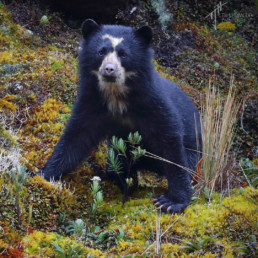The children’s character Paddington Bear is an Andean or Spectacled Bear from Peru. Known as Ukuku in Quechua, it is the only species of bear native to South America, occurring in the Andes Mountains, from western Venezuela to southern Bolivia, occupying habitats ranging from desert-scrub to forests and high-altitude grasslands. Most individuals have white, spectacle- like markings around the eyes, giving rise to the alternative name “Spectacled Bear,” though not all spectacled bears have “spectacle” markings. The pattern and extent of pale markings are slightly different on each individual bear, and bears can be readily distinguished by this.

Secretive Habits
Andean Bears are very reclusive by nature and rarely seen in the wild, making species monitoring and evaluation a difficult task. They leave messages for other bears by rubbing
their backs against the tree trunks, leaving scratch marks with their claws, and perhaps urinating or leaving a hormonal secretion around the scratched area. They are excellent
climbers and commonly build tree platforms where they rest, feed on fruits and carcasses, as well as guard feeding areas. As food is available all year-round in most parts of their range, Andean bears do not hibernate.
Their sense of smell is extremely sensitive, and they can perceive from the ground when a tree is loaded with ripe fruit. While the diet of the spectacled bear is mostly herbivorous, it occasionally engages in carnivorous behavior, preying opportunistically on mammals, including rabbits and mountain tapirs, and unfortunately free-ranging domestic cattle.
Mountain Bear
The bear is endemic to the Tropical Andes, with a long (ca 4,600 km) and narrow (ca 200-650 km) distribution in the mountains from Venezuela to Bolivia Their altitudinal range extends from 200 to 4,750 m above sea level, where they inhabit a great variety of ecosystems including tropical dry forests, tropical moist lowland and montane forests, tropical dry and moist shrublands, and tropical high altitude shrubland and grasslands.
National Geographic Explorer and biologist Ruthmery Pillco Huarcaya is working to protect the Andean bears of Peru, inspired by the legends of her Quechua heritage
Threats:
Generally, the only threat against adult bears is humans. The main threat to the Andean Bear is from habitat loss as a result of agricultural expansion, grazing, mining, oil exploration, and road development. Due to the reduction and fragmentation of their habitat, Andean Bears increasingly raid crops and kill livestock, resulting in more retaliatory killing and illegal hunting.
Global projections of effects of climate change show a general tendency towards upslope displacement of the mountain biome, and the Tropical Andes is among the most vulnerable regions to climate change. Changes in climate regimes must therefore be considered as a growing threat for Andean Bears, as they are likely to alter habitat quality as well as land-use patterns, and increase the probability of human–bear encounters and conflict.
Based on the current state of the Andean Bear’s habitat, the fact that many threats causing reduction and degradation of Andean Bear ecosystems have not ceased, and projected patterns of biodiversity shift caused by climate change, the species is vulnerable to widespread future decline.
